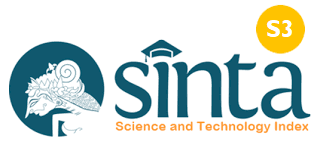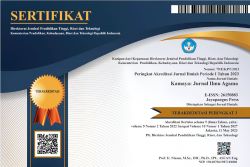Perceraian Di Luar Pengadilan Ditinjau Dari Perspektif Janda
Studi Kasus Di Desa Tanjung Medan
DOI:
https://doi.org/10.37329/kamaya.v8i3.4717Keywords:
Divorce Outside of Court, Child Custody, Child Support After Divorce, Joint Property, Islamic LawAbstract
The practice of divorce outside of religious courts in Tanjung Medan Village raises a number of issues, particularly regarding the fulfillment of children's rights and the division of joint property. The purpose is to analyze the incompatibility of this practice with Islamic law and to provide recommendations for solutions to address these issues. The research method is qualitative research using a normative empirical approach. Research findings Through a case study in Tanjung Medan Village, it was found that divorce outside religious courts often results in legal uncertainty, unfair distribution of assets, and difficulties in enforcing children's rights. This study aims to analyze to what extent such practices contradict the principles of justice in Islamic law. A thorough analysis of these findings shows that such practices are difficult to justify from an Islamic legal perspective. Re-examines the legal status of divorce outside of court, which is fundamentally permissible under fiqh, by reviewing the principles of fiqh to determine whether its legal status can change to haram, makruh, or remain permissible. The research findings are expected to serve as input for the public, religious leaders, and policymakers in achieving justice for all parties involved in the divorce process.
References
Abdurrahman. (1992). Kompilasi Hukum Islam di Indonesia (Ed. 1). Jakarta: Akademika Pressindo.
Akram, M., Idris, Muh., & Pratama, F. A. (2023). Dampak Perceraian di Luar Pengadilan terhadap Anak Perspektif Hifz Al-Nasl (Suatu Penelitian di Kota Kendari). Kalosara: Family Law Review, 2(2), 121.
al Jaziry, Abd. R. (2012). Kitab Al-Fiqh ‘Ala Mazahib Al-Arba’ah, Juz. Mesir: Maktabah Al-Tijariyah Al-Kubra.
Al-Asqallani, I. H. (2016). Bulugul Maram Min Adillatih Al-Ahkam (8 ed.). Bandung: Jabal.
Anggawira, A., & Putranto, R. D. (2025). Analisis Yuridis Peraturan Pemerintah Nomor 25 Tahun 2024 tentang Organisasi Masyarakat Keagamaan dan Pelaksanaan Kegiatan Usaha Pertambangan Mineral dan Batubara. IBLAM Law Review, 5(2), 43–57.
Azizah, L. (2012). Analisis Perceraian dalam Kompilasi Hukum Islam. Al-’Adalah, 9(2), 415–422.
Bahri, S. (2015). Konsep Nafkah dalam Hukum Islam Conjugal Need Concept in Islamic Law. Kanun Jurnal Ilmu Hukum, 66(17), 381–399.
Budiyanto, Hm. (2014). Hak-Hak Anak dalam Perspektif Islam. Raheema, 1(1).
Hudafi, H., Firmansyah, H., Nasution, R. S., & Efendi, S. (2023). Tinjauan Fikih Munakahat terhadap Berita Pernikahan Dua Wanita Kembar dengan Seorang Laki-Laki di Tribunjabar.id. Jurnal Al-Maqasid: Jurnal Ilmu Kesyariahan dan Keperdataan, 9(1), 31–43.
Ihwanudin, N. (2019). Pemenuhan Kewajiban Pasca Perceraian di Pengadilan Agama. Adliya: Jurnal Hukum dan Kemanusiaan, 10(1), 51–68.
Ilham, M., Misbahuddin, Alimuddin, Kurniati, & Asni. (2024). Problematika Perceraian di Luar Pengadilan dan Implikasinya terhadap Hak-Hak Perempuan dan Anak (Studi di Desa Bambu, Kec. Mamuju Kab. Mamuju, Sulawesi Barat). Jurnal Review Pendidikan dan Pengajaran, 7(3), 7337.
Marimin, A. (2022). Konsep dan Perkembangan Teori Maqasi. Jurnal Ilmiah Ekonomi Islam, 8(2), 2049–2058.
Maryati, M. (2021). Dasar Pertimbangan Hakim Menetapkan Hak Asuh Anak kepada Suami Selaku Pemohon pada Pengadilan Agama Jambi. Jurnal Ilmiah Universitas Batanghari Jambi, 21(3), 1299.
Nawafitrid, V., Widyaningrum, A., P, I. F. E., S, F. H. N., & Ashshidiqqi, E. A. (2024). Hak-Hak Istri dan Anak Pasca Cerai Talak. Jurnal Bevinding, 1(12), 21–31.
Novalia, S., & Hakim, A. R. (2024). Melindungi Hak Perempuan dan Anak Pasca Perceraian: Perspektif Hukum Islam dan Hukum Positif Indonesia. Jurnal Mediasas: Media Ilmu Syari’ah dan Ahwal Al-Syakhsiyyah, 7(2), 639–655.
Novialita BT, S. I., Ernanto, M. B., Jakaria, M. N., Juniarsih, H., & Trinita, C. H. (2025). Pendampingan Bantuan Hukum bagi Pasangan yang Terpisah Tanpa Penyelesaian Perceraian secara Hukum. Causa: Jurnal Hukum dan Kewarganegaraan, 11(5), 101–110.
Nurhadi, N. (2019). Illegal Divorce in Perspective of Islamic Law and Indonesian Law. Al-Mawarid Jurnal Syariah dan Hukum (JSYH), 1(2), 179–201.
Nurmayani, S., Zahara, S., Dewita, C. F., Wahyuni, I., Izwani, P. K., & Pratama, M. R. (2025). Tinjauan Literatur Mengenai Perceraian dalam Hukum Islam: Sebab dan Konsekuensinya. Jurnal Riset Rumpun Agama dan Filsafat, 4(1), 16–27.
Oktavia, N. (2022). Dimensi Pembangunan Berkelanjutan dalam Mencegah Dampak Perceraian terhadap Psikologi Anak: Studi Kasus di Kecamatan Lenek. Journal of Sustainable Development Issues, 1(1), 19–28.
Ratnawaty, L. (2021). Aspek Yuridis Mengenai Pembagian Harta Bersama Akibat Perceraian di Kota Bogor. Yustisi, 8(1), 1–14.
Ropei, A., & Sururie, R. W. (2021). Dinamika Penjatuhan Talak melalui Whatsapp dalam Paradigma Pembaharuan Hukum Keluarga Islam. Al-Hukama’, 11(1), 160–184.
Syahputra, A. (2014). Perwalian Anak dalam Bingkai Hukum. Bandung: Media Perintis.
Tarmizi, T., Pradiba, Y., & Usman, K. (2023). Hak Asuh Anak (Hadhanah) Pasca Perceraian serta Akibat Hukumnya. Journal Ilmu Hukum Pengayoman, 7(1), 13–27.
Triyanita, L. S., & Prananingtyas, P. (2023). Hak Anak Akibat Perceraian Berdasarkan Undang-Undang Perkawinan dan Kompilasi Hukum Islam. Notarius, 16(2), 850–860.
Yazid, I., Adly, M. A., & Tamami, A. (2022). Kesejahteraan Keluarga Pasangan Hasil Dispensasi Kawin di Kota Medan: Perspektif Maslahah Mursalah. Al-Mashlahah Jurnal Hukum Islam dan Pranata Sosial, 10(02).
Yuniarti, A., & Saifullah. (2023). Konsep Talak Perspektif Wahbah Az-Zuhaili, Muhammad Jawad Mughniyah, dan Kompilasi Hukum Islam. Journal of Economics, Law, and Humanities, 2(1), 59–78.
Downloads
Published
How to Cite
Issue
Section
License
Copyright (c) 2025 Kamaya: Jurnal Ilmu Agama

This work is licensed under a Creative Commons Attribution-ShareAlike 4.0 International License.
An author who publishes in the Kamaya : Jurnal Ilmu Agama agrees to the following terms:
- Author retains the copyright and grants the journal the right of first publication of the work simultaneously licensed under the Creative Commons Attribution-ShareAlike 4.0 License that allows others to share the work with an acknowledgement of the work's authorship and initial publication in this journal
- Author is able to enter into separate, additional contractual arrangements for the non-exclusive distribution of the journal's published version of the work (e.g., post it to an institutional repository or publish it in a book) with the acknowledgement of its initial publication in this journal.
- Author is permitted and encouraged to post his/her work online (e.g., in institutional repositories or on their website) prior to and during the submission process, as it can lead to productive exchanges, as well as earlier and greater citation of the published work (See The Effect of Open Access).
Read more about the Creative Commons Attribution-ShareAlike 4.0 Licence here: https://creativecommons.org/licenses/by-sa/4.0/.





